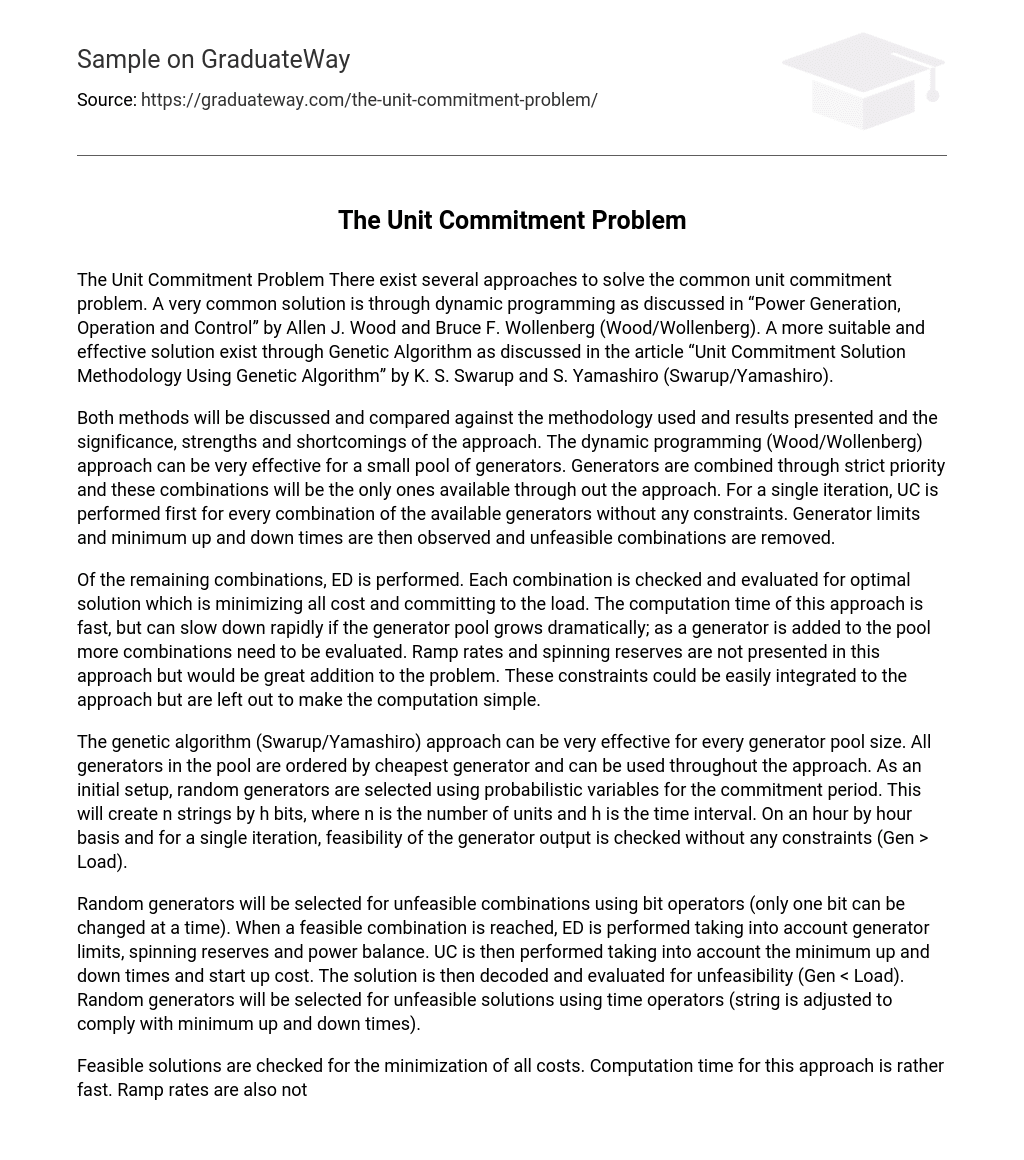The Unit Commitment Problem There exist several approaches to solve the common unit commitment problem. A very common solution is through dynamic programming as discussed in “Power Generation, Operation and Control” by Allen J. Wood and Bruce F. Wollenberg (Wood/Wollenberg). A more suitable and effective solution exist through Genetic Algorithm as discussed in the article “Unit Commitment Solution Methodology Using Genetic Algorithm” by K. S. Swarup and S. Yamashiro (Swarup/Yamashiro).
Both methods will be discussed and compared against the methodology used and results presented and the significance, strengths and shortcomings of the approach. The dynamic programming (Wood/Wollenberg) approach can be very effective for a small pool of generators. Generators are combined through strict priority and these combinations will be the only ones available through out the approach. For a single iteration, UC is performed first for every combination of the available generators without any constraints. Generator limits and minimum up and down times are then observed and unfeasible combinations are removed.
Of the remaining combinations, ED is performed. Each combination is checked and evaluated for optimal solution which is minimizing all cost and committing to the load. The computation time of this approach is fast, but can slow down rapidly if the generator pool grows dramatically; as a generator is added to the pool more combinations need to be evaluated. Ramp rates and spinning reserves are not presented in this approach but would be great addition to the problem. These constraints could be easily integrated to the approach but are left out to make the computation simple.
The genetic algorithm (Swarup/Yamashiro) approach can be very effective for every generator pool size. All generators in the pool are ordered by cheapest generator and can be used throughout the approach. As an initial setup, random generators are selected using probabilistic variables for the commitment period. This will create n strings by h bits, where n is the number of units and h is the time interval. On an hour by hour basis and for a single iteration, feasibility of the generator output is checked without any constraints (Gen > Load).
Random generators will be selected for unfeasible combinations using bit operators (only one bit can be changed at a time). When a feasible combination is reached, ED is performed taking into account generator limits, spinning reserves and power balance. UC is then performed taking into account the minimum up and down times and start up cost. The solution is then decoded and evaluated for unfeasibility (Gen < Load). Random generators will be selected for unfeasible solutions using time operators (string is adjusted to comply with minimum up and down times).
Feasible solutions are checked for the minimization of all costs. Computation time for this approach is rather fast. Ramp rates are also not considered in this approach but can be easily integrated to the problem. In the real world, pools of generators are large. This can only mean that dynamic programming (Wood/Wollenberg) would not be very effective especially after taking into account ramp rates. One can assume that dynamic programming can be used to solve the UC problem by sub pools within a large pool of generators.
But that is neither efficient nor realistic to the real world. That leaves the genetic algorithm (Swarup/Yamashiro) approach with a great advantage. Since the genetic algorithm approach can handle any pool of generators, solutions can always be optimal even with the integration of ramp rates. Then again, with this approach there is always a probability that some generators will produce a certain MW (reproduction), that some generators will be available (mutation) and that some generator will remain cheap (crossover) throughout the problem.
This can be a downside since a new constraint is added; the availability of a generation history. The history would be composed of what units had a stable MW, what units were available and what units were cheap for some period in the past. But with a good history, the probabilistic variables can become more realistic. And with more realistic variables, the solution can become optimal. Companies can grow on this approach especially since there is room for the modification to consider other constraints.
The unit commitment problem is constantly being researched for a better approach to solve the problem. Two very common approaches were discussed, the dynamic approach in the book “Power Generation, Operation and Control” by Allen J. Wood and Bruce F. Wollenberg (Wood/Wollenberg) and the genetic algorithm approach in the artcle “Unit Commitment Solution Methodology Using Genetic Algorithm” by K. S. Swarup and S. Yamashiro (Swarup/Yamashiro). They take into consideration the minimum up and down time constraints, the start up costs and generator limits.
The approaches are discussed for a short term period and ample explanation on how each method works is discussed. In very simple terms, dynamic programming sets the approach through strict priority of the generators. That way, the cheapest generators are only available throughout the approach. With genetic algorithm, all generators are available and ordered by cheapest generator. The approach is probabilistic in that reproduction, mutation and crossover variables are presented. Both approaches are solved differently but a single optimized solution can be obtained through both.





